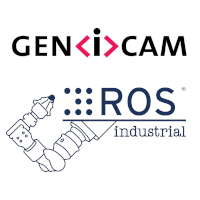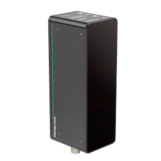Whether for goods inspection on conveyor belts, pick-and-place applications in robotics or collision avoidance for automated guided vehicles (AGV)—as a raw data sensor, the SmartRunner Explorer 3-D is suitable for a wide range of applications that require detailed contour detection. Due to its temperature-regulating aluminum housing, the rugged sensor with IP65 certification delivers reliable measurement results even in the most demanding applications. It is optionally available with stereo vision technology or time-of-flight (ToF) technology and generates high-precision 3-D point cloud images in addition to 2-D images.
Together with the integrated Ethernet Gigabit interface, 2-D and 3-D images can be generated significantly faster and without data loss. Thanks to the high chip resolution, even the smallest objects and their properties can be precisely mapped and transferred to a coordinate system or an individual application using the depth information in the z direction. Since the sensor is already delivered in a calibrated state, it is immediately ready for use. This reduces the time required for programming and integrating the device into the application many times over.
Universal Interfaces for the Simple Implementation of Vision Applications

The integrated Ethernet TCP/IP interface and the available DLL simplify the integration of the sensor into the respective programming environment. The SmartRunner Explorer 3-D is also equipped with the universal GenICam and ROS interfaces. This eliminates the need for familiarization with manufacturer-specific interfaces. Instead, users receive standardized access to data and parameters. In addition, GenICam and ROS enable access to a variety of programming modules in software libraries. This saves time and costs when implementing image processing applications.
Overview 3-D Vision Sensors

The sensor with stereo vision technology is equipped with two cameras with a resolution of 1.4 MP. By superimposing two 2-D images, the stereo vision version automatically determines a disparity image, which is used to create a 3-D point cloud in the end. It is ideally suited for applications with short detection ranges.

The sensor with Time-of-Flight Technology has a camera with VGA resolution (640 x 480 px) and a high measuring rate of 30 Hz. This makes it especially suitable for applications with a larger measuring range where faster response times are essential—for example in driverless transport systems. The 940-nanometer infrared light means that the ToF sensor is insensitive to ambient light and can be used equally effectively both indoors and outdoors.







 +358 20 7861 290
+358 20 7861 290